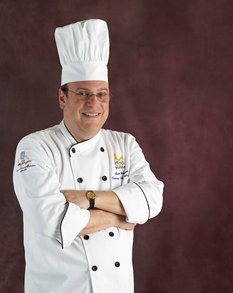50-Minute Classroom: Teaching Nutrition, Part 2
31 March 2012
 In a continuation of last month’s focus on teaching nutrition within a short class period, Chef Weiner explains how to emphasize the remaining six of 10 unchanging basic facts.
In a continuation of last month’s focus on teaching nutrition within a short class period, Chef Weiner explains how to emphasize the remaining six of 10 unchanging basic facts.
By Adam Weiner, CFSE
Last month I wrote about why culinary teachers find it challenging to teach about nutrition, and gave the first four topics to cover in a 50-minute classroom:
1. To lose weight, you must consume fewer calories than you burn (or burn more than you consume).
2. To be healthy, you must consume a wide variety of foods.
3. Generally, the closer food is to its natural form, the healthier it is.
4. Yes, Virginia, you really do need to have some fat in your diet.
This month we finish our list of 10 things to teach about nutrition.
5. Some Fats Are Worse for You than Others. Nutritionally, the worst fats are saturated fats and trans fats. Saturated fats, generally speaking, are fats that are solid at room temperature. They are commonly derived from animals. Trans fats—which were originally thought to be a healthy alternative to saturated fats (remember my writing that the rules keep changing)—are now considered to be as bad or worse than saturated fats. It is generally recommended that these two types of fat be kept to a minimum.
6. Some Fats Are Actually Healthy for You. Omega fatty acids from plants and fish are considered to be. Polyunsaturated fats and monounsaturated fats are considered to be the healthiest. Polyunsaturated fats include olive oil, nuts, soybeans, peanut butter and sesame oil. Olive oil is monounsaturated. Polyunsaturated and monounsaturated fats commonly are liquid at room temperature.
7. Fad Diets Work, but Only for a While. Fad diets work because they are basically set up so that you will consume fewer calories than you burn and/or they are really just water-loss diets. Forgetting long-term health issues, the problem with fad diets is that no one can maintain them forever. When the person goes off the diet, the weight goes back on. This is called yo-yo dieting, which might be more detrimental, health-wise, than just remaining overweight. What we need to teach our students is to develop a more-healthy diet overall.
8. Alcohol and Coffee Drinks Are Worse than Empty Calories. When we were growing up, we were taught that alcohol is empty calories—meaning that there is no nutritional value. That hasn’t changed. What has changed is that our students are getting more and more of their daily calories from coffee “drinks.” Black coffee and espresso have zero calories, but the milk, cream, caramel, soy milk, chocolate, etc. that is added makes these drinks very high in empty calories, most of which come from fat. One drink prominent at a major coffee chain has nearly 700 calories—which is 35% of a 2,000-daily-calorie diet just from one beverage!
9. Spoil Yourself. It’s okay to treat yourself once in a while to ice cream, candy, fries, cookies or a steak. Treating yourself in limited quantities and frequency leads to more-healthy eating overall. Looking forward to rewarding yourself with a treat can make it easier to keep eating healthy in the interim.
10. Don’t Obsess. Many students start trying to eat healthy and then they slip. A bag of chips or a burger won’t kill them. What will cause them harm is that they justify going off a healthy diet by saying that they have fallen off the wagon. As the old saying goes, three steps forward and one backward is still two steps forward. However, some students—particularly in their pre-teen and teen years—obsess about dieting and weight. Culinary instructors, unlike counselors or school nurses, get to watch students eat and hear them talk about food. If you notice anything that might be a warning sign of an eating disorder, it is your moral, ethical and legal duty to get help for that student.
If you want a one-word summary to teach your students: MODERATION. Don’t go to extremes either way in nutrition and dieting and you will do fine.
Finally, if you don’t feel competent to teach basic nutrition, it is easy to find someone who will volunteer to come in once or twice a semester. I am blessed with having Yolanda M. Gutierrez, MS, PhD, RD (who is the mom of one of my graduates), come by every few months. Check with your local hospital, county Health Department or Department of Education. They probably would be more than happy to send in a guest teacher.
Chef Adam Weiner, CFSE, teaches a 20-week Introduction to Cooking program for JobTrain on the San Francisco Peninsula.
